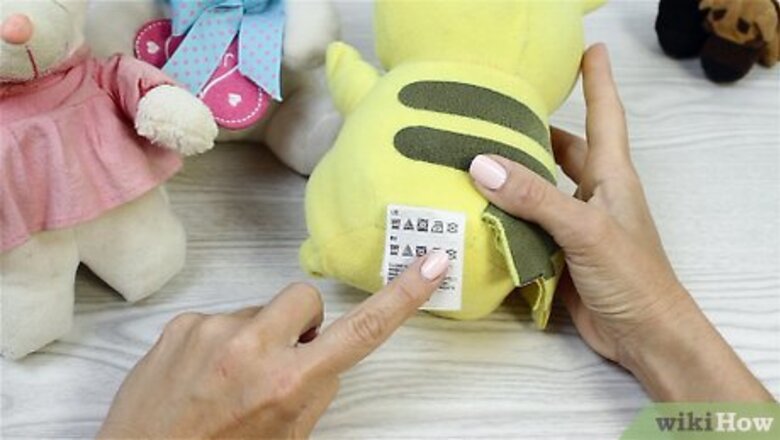
views
Using a Washing Machine
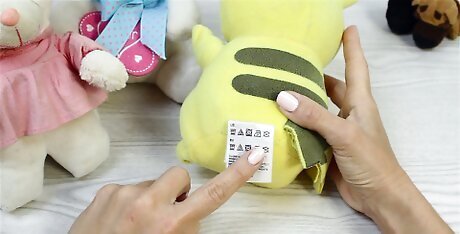
Make sure that you’re able to machine wash your stuffed animal. Read the label of the animal to ensure that you are able to wash it in your machine. You won’t be able to machine a stuffed animal if: Your stuffed animal comes with a music box inside. It’s very old, fur or limbs are falling apart, or it’s fragile to hold. There are items that have been glued on like plastic eyes, legs, arms, ears, or sequins. The animal is wearing delicate clothing that is sewn permanently on and can’t be removed like a glittery dress or an easily broken crown. The animal is stuffed with small foam balls instead of batting.
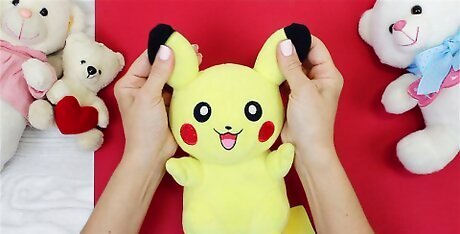
Examine the animal carefully. Do you need to remove any parts? Are there any loose strings that need to be taken care of? Make sure that you don’t cause any damage to the animal or your machine.
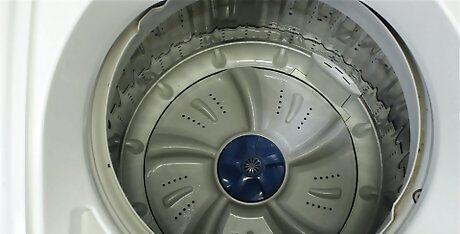
Find out what type of machine you have. Stuffed animals are best washed in a machine that does not have an agitator. Machines with an agitator tend to ball up the animal because the agitator displaces the batting. Instead of using a top loading machine, you could take a large load of laundry to a laundromat and wash your stuffed animal with that load.
Place your animal in a mesh bag. A mesh laundry bag can be purchased at your local dollar store, fabric store, or laundromat. It gives added protection from snagging and jostling by your machine.
Use the gentle or delicate cycle. Even a normal cycle may be too vigorous for your stuffed animal so always wash in gentle or delicate to be safe. Use warm or cool water. Avoid using hot water because it may dissolve any glue causing pieces to fall off.
Washing by Hand
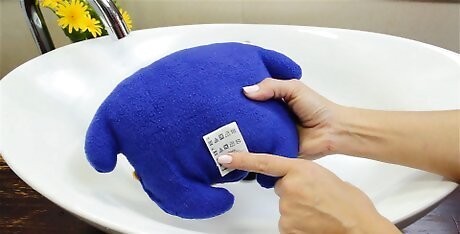
Read the label. Your stuffed animal may say hand wash only or wash on delicate cycle. Your toy may be too fragile for delicate so hand washing may be the best way to give it a thorough clean without damaging it. Don’t just spot clean in case the stain has penetrated beneath the surface. If a stain gets into the stuffing, germs and odors can linger. For example, if a child is potty training and urinates on the toy, the insides may be soaked despite rinsing any visual signs of the stain away.
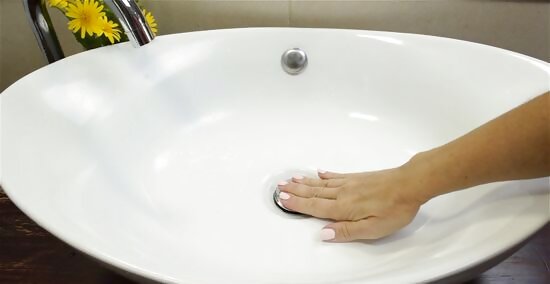
Fill your sink with cold water and a cup of delicate soap. Use a plug so your sink fills with water or use a large container, like a bucket or basin, and fill it with cold water and delicate soap. Make sure you read whether the soap is best suited for the material of your stuffed animal. Strong soaps may discolour or damage your animal. Don’t use too much soap or it may be difficult to rinse off.
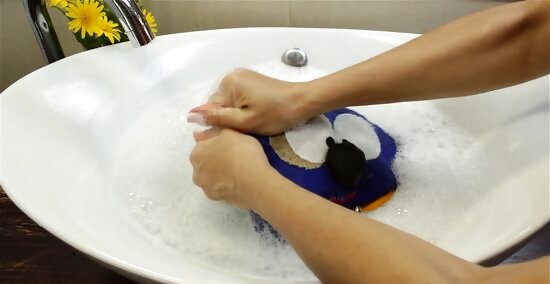
Immerse your stuffed animal. Fully immerse your animal so that the soap water mixture gets into the innards and fights the stain thoroughly. Gently clean the animal as it is immersed. Use your hands to gently rub the material and get out any debris or stains.
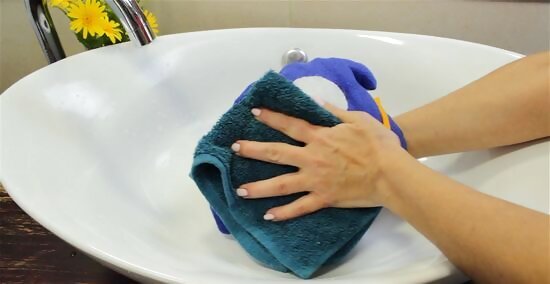
Rinse off all the soap. Thoroughly rinse out all the soap. Get as much water out as possible. Don’t shake or twist the animal. Press it between old towels as you squeeze the water out. You may gently ring out your animal depending on its condition. Older animals may easily fall apart if mishandled.
Let it dry. Re-fluff and reshape your animal. Allow it to sit and dry. Don’t place it directly near heat or sunlight or it might become discolored or misshaped.
Spot clean a surface stain. If there’s only a little dirt on the surface or your tag says, “surface clean only”, use a gentle cleanser. You may use upholstery shampoo that creates foam to remove the stain. Read the ingredients to make sure there aren’t any harsh chemicals that could be harmful to a child. Your child may place the toy in her mouth so be sure that any cleaning agent is safe. There are numerous cleaners that are marketed specifically for cleaning stuffed animals. Find a cleaner that’s safe and works for you. You may also use unscented baby detergent with a damp cloth to spot clean.
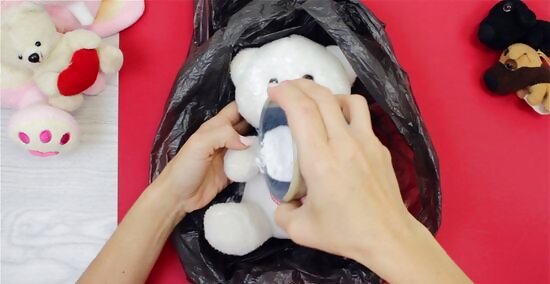
Use a garbage bag and baking soda. If your animal is averaged size, place it in a large garbage bag with ½ cup baking soda. You may add more baking soda if it is quite large. Close the bag firmly and give it a good shake. Keep the bag closed and let the animal sit for 15 - 20 minutes. Open the bag and brush off the excess baking soda. You may use a vacuum if you feel your animal will not get damaged. Do not shake the bag too vigorously if you feel your animal will come apart.
Drying Your Stuffed Animal
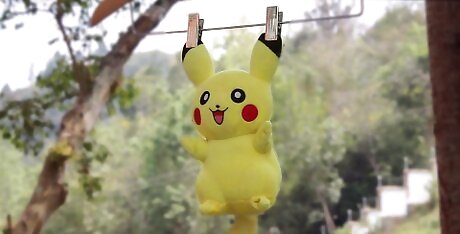
Use a clothesline. The wetter your toy, the longer it will take to dry. Make sure all the excess water is gone before drying your animal on a clothesline. On a sunny day, use clothespins to hang your toy and set it to dry. The sun is a natural stain remover and sanitizer. Spot cleaning doesn’t require a lot of water, so you probably won’t need to hang out an animal that has been spot cleaned.
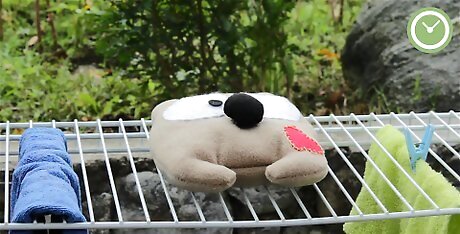
Air dry your animal. Let your stuffed animal air dry if the weather isn’t cooperating. Simply let it sit in a protected area, away from pets and children.
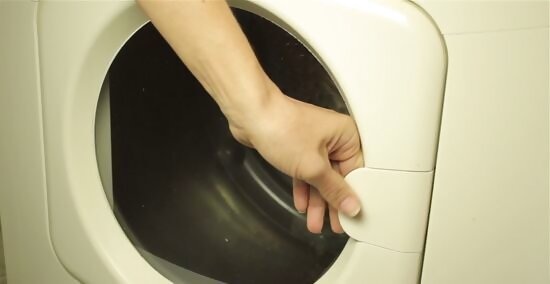
Use a dryer. If your label indicates that you are able to use a dryer, place your animal in a dryer on low heat or permanent press. You may also use a hair dryer on a low setting or on cool. While heat dries the animal quickly, it can also damage the animal or mat the fur. If your dryer has a fluff air setting, use this to help maintain the fur.
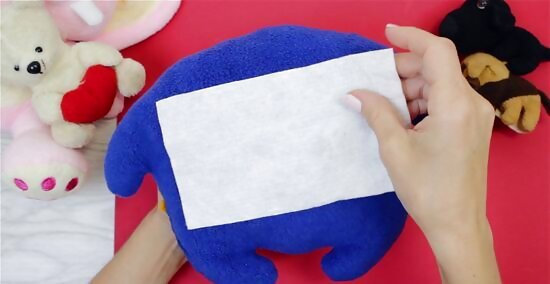
Avoid tumble drying. Add towels into your load to soften the movements of your animal. Also use dryer sheets to eliminate static electricity buildup so your little one doesn’t get shocked when first holding it.
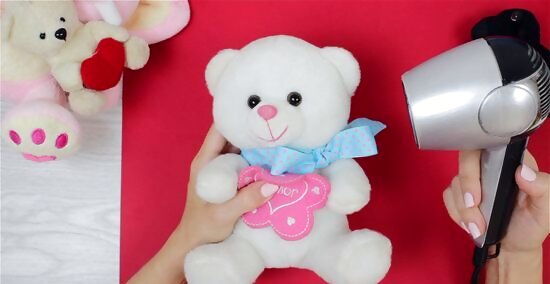
Ensure both the inside and outside are dry. The inside takes longer than the outside to dry. Make sure the inside is dry or else mildew may grow, which can be hazardous to a child’s health. Use a dryer or hair dryer for a short period to hasten the process.
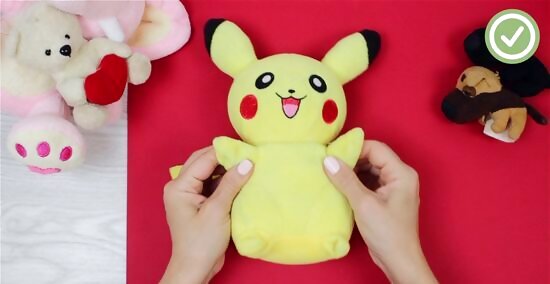
Reposition and reshape the animal. The stuffing may have jostled during the drying process so reshape your animal and fluff the fur so that it looks like the original version.


















Comments
0 comment